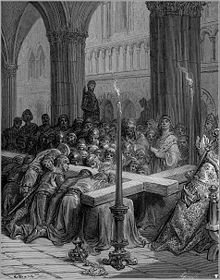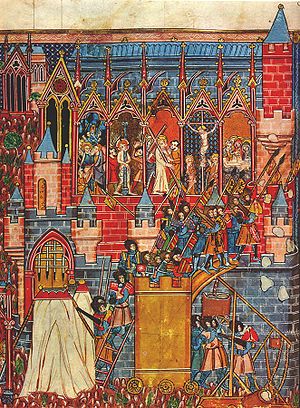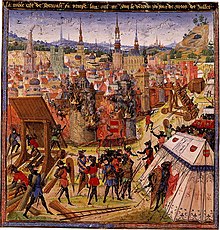Siege of Jerusalem (1099)
| date | June 7th to July 15th 1099 |
|---|---|
| place | Jerusalem |
| output | Victory of the Crusaders |
| Parties to the conflict | |
|---|---|
| Commander | |
|
Robert of Flanders |
Iftikhar ad Daula (Commander of Jerusalem) |
| Troop strength | |
| 1,500 knights 12,000 foot soldiers |
20,000 |
| losses | |
|
unknown |
unknown. |
The siege of Jerusalem as part of the First Crusade took place from June 7th to July 15th, 1099.
background
Jerusalem before the arrival of the crusaders
Jerusalem had been defended and conquered again and again in the course of the occupation by changing Islamic princes. Since the turn of the millennium, the rulers over Jerusalem changed more frequently and the situation for Jews and Christians in Jerusalem changed between repressive tolerance, massive discrimination and deadly persecution. On October 18, 1009, under the Fatimid caliph al-Hakim, the Church of the Holy Sepulcher in Jerusalem, the most important shrine of Christianity, was destroyed. Christian pilgrims from Europe repeatedly got caught between the fronts of these intra-Islamic wars. The immigrant Islamic population also fell victim to massacres by their Islamic co-religionists during the many changing conquests by Islamic armies.
Less than a year before the arrival of the crusaders before Jerusalem, the city, which had been ruled by the Sunni Seljuks under Sökmen and Ilghazi , was conquered on August 29, 1098 by the Shiite Fatimids under al-Afdal Shahanshah after a six-week siege . When the city fell, over 3,000 Sunni Muslims, Jews and Christians are said to have been killed by the Fatimid conquerors in a single night.
The first crusade
After the Byzantine emperor Alexios I Komnenos called for military support against the Seljuks , Pope Urban II called for a crusade to liberate Jerusalem in 1095 . After the successful siege of Antioch , which ended with the fall of the city in June 1098, the Crusaders stayed in the area around the city for the rest of the year. The apostolic legate Adhemar , Bishop of Le Puy-en-Velay , had died, and Bohemund of Taranto had Antioch demanded for themselves. Baldwin of Boulogne stayed in Edessa , which had also fallen to the Crusaders in 1098. There was dissent among the princes about how to proceed, and Raymond IV of Toulouse left Antioch in order to conquer the fortress of Ma'arrat al-Numan . Towards the end of the year the common knights and the foot soldiers threatened to march into Jerusalem without them.
The siege of Arqa
In late December or early January, Robert of Normandy and Bohemond's nephew Tankred agreed to become Raimund's vassal , rich enough to pay them for their services. However, Godfrey of Bouillon , who now had income from his brother Baldwin's property in Edessa, refused. On January 5th the walls of Ma'arrat were razed , on January 13th the march south began, barefoot and in pilgrim clothes, followed by Robert and Tankred. On their way along the Mediterranean coast they faced little resistance, local Muslim rulers preferred to keep peace and deliver supplies. The Sunnis also seem to have preferred the Crusader government to the Shiite Fatimid government.
Raimund planned to keep Tripoli for himself and to found a state that would correspond to the Bohemond in Antioch. First, however, Arqa was besieged nearby. In the meantime, Gottfried and Robert von Flanders , who had also refused to become Raimund's vassal, met with the remaining crusaders in Latakia and began their march south in February. Bohemond went with her for a while, but quickly returned to Antioch. At this time Tankred left Raimund's services after some unspecified friction and joined Gottfried. Another troop, albeit linked to Gottfried, was led by Gaston IV von Béarn .
Gottfried, Robert, Tankred and Gaston reached Arqa in March, where the siege was still taking place. The situation was tense, not only among the military leaders but also among the clergy . Since Adhemar's death there had been no real leader more, and since the discovery of the Holy Lance by Peter Bartholomew in Antioch, there were complaints of fraud among different clerical factions. In April, Arnulf von Chocques asked Peter to conduct a trial by fire , which Peter underwent and died of the consequences twelve days later, so that this Holy Lance was considered a forgery.
The siege of Jerusalem
The siege of Arqa lasted until May 13th and was then abandoned without success. The Fatimids had tried to make peace on the condition that the march on Jerusalem would not take place, but this was ignored, since Jerusalem was the real goal; the Fatimid governor in Jerusalem apparently did not understand why the Crusaders were in the country in the first place. On May 13th the crusaders came to Tripoli, whose regent they supported with money and horses. According to the anonymous Chronicle Gesta Francorum , he also vowed to convert to Christianity if the Crusaders took Jerusalem from his Fatimid enemies. In the further advance the crusaders passed Beirut on May 19, Tire on May 23, and turned inland at Jaffa . They reached Ramlah on June 3rd, which had already been abandoned by its residents. The diocese of Ramlah- Lydda was established before they moved on to Jerusalem. On June 6th, Gottfried sent Tankred and Gaston to conquer Bethlehem , where Tankred planted his banner on the Church of the Nativity. On June 7th, the crusaders reached Jerusalem.
As with Antioch, the Crusaders began a siege which arguably suffered more than the city's residents due to the lack of food and water in the area. Jerusalem was well prepared for the siege; most of the Christian residents had been driven out of the city by the governor. Of the approximately 7,000 knights who had begun the crusade, only 1,500 remained, plus 12,000 healthy foot soldiers (out of about 20,000). Gottfried, Robert of Flanders and Robert of Normandy (who had now also left Raimund to join Gottfried) besieged the northern walls down to the Tower of David , while Raimund pitched his camp on the west side, from the Tower of David to Mount Zion . A storm attack on June 13 was a failure. Without food and water, the Crusaders knew that time was running against them. Coincidentally, shortly after the attack, some Christian ships reached the port of Jaffa so that the crusaders could supply themselves for a short time. They began to bring wood from Samaria to build siege engines. At the end of June, the news reached her that a Fatimid army was marching from Egypt .
The barefoot procession
Faced with an apparently impossible goal, their morale was lifted when a priest named Peter Desiderius spoke of a divine vision to the spirit of Adhemar, who had instructed them to fast for three days and then march barefoot around the city walls, after which the city - the biblical one Following the example of Joshua in the siege of Jericho - will fall within nine days. Already starving, they fasted and began their procession on July 8th, during which the clergy blew trumpets and sang psalms , and during which they were mocked all the time by the city's defenders. The procession stopped at the Mount of Olives , where Peter the Hermit , Arnulf von Chocques and Raimund von Aguiler gave sermons.
The storm and the massacre
During the siege the walls were attacked again and again, every attack was repulsed. In the meantime, however, the siege engines had been completed and, to the great surprise and concern of the garrison, could be pushed against the walls on the night of July 14th. The next morning Gottfried's tower reached its wall section near the northeast corner gate, a Flemish knight named Lethold was the first to enter the city after the Gesta Francorum . He was followed by Gottfried, his brother Eustach , Tankred and their men. Raimund's tower was held up by a moat, but when the other crusaders were already pouring into the city, the Muslim guard of the gate surrendered to him.
After the crusaders had overcome the outer walls and penetrated the city, according to the latest information about 3000 inhabitants of the city were killed in the course of the afternoon, the evening and the next morning - Muslims and Jews without distinction. The sources used in the past on the consequences of the conquest for the inhabitants of Jerusalem have been questioned in recent research. On the one hand, most Christian sources are based on the Gesta Francorum , which is not to be seen as an eyewitness account, but as a medieval epic in the style of the Roland song . On the other hand, the first Muslim sources were not created until the 1150s and thus decades after the conquest of Jerusalem. Therefore, the historical accuracy of the bloodthirsty brutality of depictions of the capture of Jerusalem is doubtful. In many cases the exaggeration is obvious, for example when the Gesta Francorum reports on the slaughter of Muslims in the Al-Aqsa mosque , "which was ... so big that our men waded in blood up to their ankles". According to the even more drastic representation by Raimund von Aguilers (who used the Gesta as the source text) “the men rode in blood up to their knees and their bridles”. William of Tire , who was not an eyewitness and only wrote his Chronica from 1170, reports:
“It was gruesome to see how the slain lay about everywhere and parts of human limbs, and how the ground was completely covered with the spilled blood. And not only were the mutilated corpses and the cut off heads a terrible sight, the greatest shudder must have been that the victors themselves were covered with blood from head to toe. Around ten thousand enemies are said to have perished in the circumference of the temple, not counting those who were killed here and there in the city and whose corpses were lying around in the streets and in the squares, because the number of these is said not to have been less be. The rest of the army dispersed in the city and pulled out like cattle those who had hidden in narrow and hidden streets to escape death like cattle and knocked them down. Others banded together in droves and went into the houses, where they tore out the fathers of the family with their wives and children and all the servants and either pierced them with their swords or fell down from the roofs so that they broke their necks. "
Such descriptions were based on Old Testament reports such as the one about the conquest of Jericho by the Israelites under Joshua , in which, according to Jos 6 EU , all residents of the city were banned , that is, they were slain.
Tankred claimed the temple district for himself and offered some Muslims his protection there, but could not prevent them from being killed by his fellow crusaders. The Fatimid governor retired to the Tower of David, which he soon handed over to Raimund for free retreat for himself and his bodyguard to Askalon .
According to an anonymous Syrian chronicle, the numbers in Arabic sources vary between 30,000 deaths and 70,000 according to the chronicler Ibn al-Atir . Contemporary Christian data also assumed 10,000 deaths, but these high numbers have been refuted by recent research. Based on a Hebrew source, it is now assumed that 3000 victims were taken when Jerusalem was captured, during which many prisoners were also taken. It can be concluded from this that in the Middle Ages the idea of the brutality of the Crusaders on both sides of the conflict was a subject of manipulation and exaggeration.
The number of those killed in the massacre is also called into doubt by the historian Peter Thorau : Although the population of Jerusalem in 1099 is unclear, it is almost impossible that the city had such a high population as indicated in the medieval sources. In general, mediaeval chroniclers tend to exaggerate the estimated numbers of troops and losses. The contemporary Jewish manuscripts discovered in the geniza of the Ben Esra Synagogue in Cairo in 1890 also clearly show that at least some Jews survived the massacre and escaped Jerusalem.
consequences

After the conquest, on July 22nd, Godfrey of Bouillon took control of Jerusalem as Princeps , after Raimund had previously refused the royal crown offered to him on the grounds that he did not want to wear a royal crown in the city where Jesus Christ had worn the crown of thorns . After Raimund had also handed over the Tower of David and left the city, Arnulf von Chocques, whom Raimund had rejected because of his support for Peter Bartholomäus, was elected the first Latin Patriarch on August 1st (the Orthodox Patriarch was then in exile). On August 5th, after questioning some of the exiled people who had returned, Arnulf discovered the " True Cross Relic ".
On August 12, Gottfried led an army, the Holy Cross in the vanguard, into the battle of Ascalon against the Fatimids. The Crusaders were successful, but after the victory the majority of them felt they had fulfilled their crusade vows, so all but a few hundred knights returned home. Yet the victory cleared the way for the establishment of the Kingdom of Jerusalem .
Literary and musical adaptations
- The siege and capture of Jerusalem by the Crusaders is the theme of Giuseppe Verdi's opera I Lombardi alla prima crociata, which premiered in 1843, based on a libretto by Temistocle Solera . Verdi's second version of the opera, entitled Jérusalem, also deals with this subject.
- Georg Friedrich Handel's first opera for London Rinaldo (1711) also deals with the siege and capture of the city by Gottfried von Bouillon . The libretto is by Giacomo Rossi based on models by Aaron Hill and ultimately Torquato Tasso .
Individual evidence
- ↑ Hannes Wendtlandt (transl.): Paolo Cau: The 100 greatest battles. From Kadesh (1285 BC) to today, Fränkisch-Crumbach 2012, p. 78.
- ^ Conor Kostick: The siege of Jerusalem. Crusade and conquest in 1099. Continuum, London 2009, ISBN 978-1-84725-231-9 , pp. 55 f.
- ↑ Michael A. Köhler: Alliances and treaties between Frankish and Islamic rulers in the Middle East. Walter de Gruyter, Berlin 1991, ISBN 3-11-011959-5 , p. 61 ff.
- ↑ Thomas S. Asbridge: The Crusades . Klett-Cotta, 2016, p. 125, 127 f .
- ^ Wilhelm of Tire: Historia rerum in partibus transmarinis gestarum. Book VIII, chap. 20 ( online , accessed September 15, 2010)
- ↑ Nikolas Jaspert : The Crusades. Scientific Book Society, Darmstadt 2008, p. 42.
- ↑ Thomas S. Asbridge: The Crusades . 7th edition. Klett-Cotta, 2016, ISBN 978-3-608-94921-6 , pp. 117 ( google.at ).
- ↑ See Edward Peters: The First Crusade. The chronicle of Fulcher of Chartres and other source materials. University of Pennsylvania Press, Philadelphia 1998, ISBN 0-8122-1656-3 , pp. 263 ff.
literature
- Guy Lobrichon: The conquest of Jerusalem in 1099. Thorbecke, Sigmaringen 1998, ISBN 3-7995-0093-6 .
- Hans Eberhard Mayer : History of the Crusades . 10th edition. Kohlhammer, Stuttgart 2005, ISBN 3-17-018679-5 .
- Jonathan Riley-Smith : The First Crusade and the Idea of Crusading. Continuum, London 2003, ISBN 0-8264-6726-1 .
- Peter Thorau: The Crusades. CH Beck, Munich 2004, 4th edition 2012, ISBN 978-3-406-50838-7 .
- Nikolas Jaspert : The Crusades. Scientific Book Society, Darmstadt 2003, ISBN 3-534-15129-1 .
Web links
- The Siege and Conquest of Jerusalem: Collected Reports Main source from the Internet Medieval Sourcebook .
- Climax of the First Crusade Detailed study by J. Arthur McFall originally published in Military History magazine.
- One hour of history: https://www.deutschlandfunknova.de/beitrag/kreuzzuege-die-belagerung-jerusalems-1099

